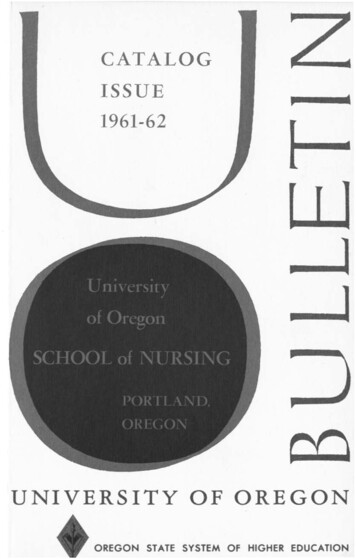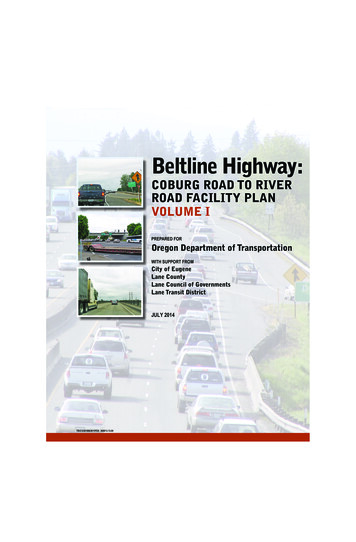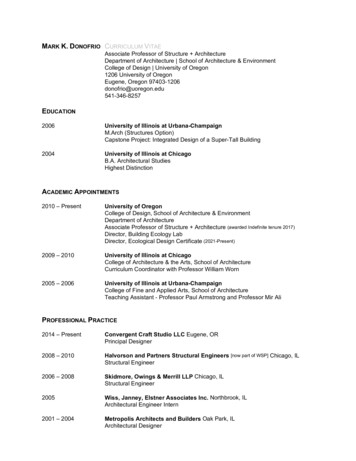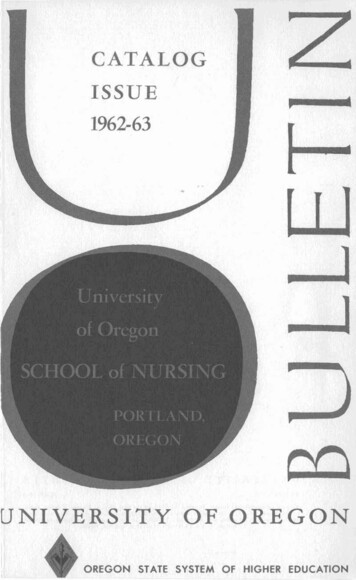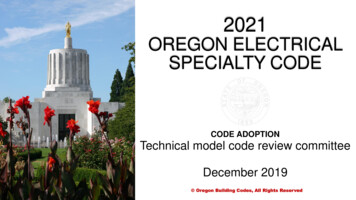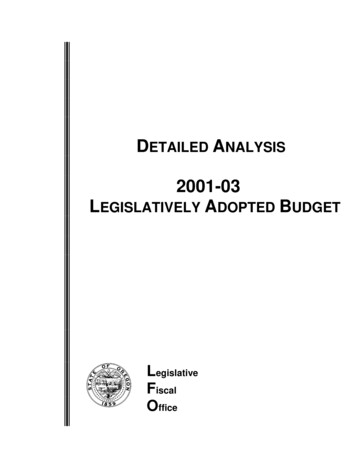
Transcription
DETAILED ANALYSIS2001-03LEGISLATIVELY ADOPTED BUDGETLegislativeFiscalOffice
STATE OF OREGONLEGISLATIVE FISCAL OFFICE900 COURT STREET NEH-178 STATE CAPITOLSALEM OR 97301-4048PHONE 503-986-1828FAX 503-373-7807KEN ROCCOLEGISLATIVE FISCAL OFFICERPEGGY ARCHERDEPUTY LEGISLATIVE FISCAL OFFICERDecember 17, 2001To the Members of the Seventy-First Oregon Legislative Assembly:I am pleased to submit the Legislative Fiscal Office Detailed Analysis of the 2001-03Legislatively Adopted Budget. The following expanded narrative includes discussion ofagency and program revenue sources, performance measures, Governor’s proposedspending, and the specific budget actions taken by the 2001 Legislative Assembly.I trust you will find this report useful. Please feel free to call the Legislative Fiscal Officeat 503-986-1828 should you have further questions.Sincerely,Ken RoccoLegislative Fiscal Officer
LEGISLATIVE FISCAL OFFICEKen Rocco, 503-986-1844Legislative Fiscal OfficerNatural ResourcesGina Rumbaugh, 503-986-1828Office ManagerWays and Means CoordinatorPeggy Archer, 503-986-1837Deputy Legislative Fiscal OfficerLegislative BranchJoan Diaz, 503-986-1828Administrative SupportFiscal Impact CoordinatorPrincipal and Senior Legislative Analysts – Budget AnalysisSheila Baker, 503-986-1838Children’s ProgramsHuman Services – Mental HealthSteve Bender, 503-986-1836Higher EducationJohn Britton, 503-986-1816Human Services – Adult and FamilyHuman Services – Senior and DisabledOregon Health PlanSusan Jordan, 503-986-1835TransportationParks and RecreationRobin LaMonte, 503-986-1845Judicial BranchEconomic DevelopmentConsumer and Business ServicesSue MacGlashan, 503-986-1817K-12 EducationPublic Utility CommissionRevenue DepartmentLarry Niswender, 503-986-1839Public SafetyRick Olsen, 503-986-1840Human Services – Alcohol and DrugHuman Services – Health DivisionHousing and Community ServicesDallas Weyand, 503-986-1834AdministrationConstitutional OfficesEmployee Compensation and BenefitsLegislative Analysts – Fiscal Impact and Program ReviewJudi James, 503-986-1842Human ServicesNatural ResourcesAdrienne Sexton, 503-986-1841AdministrationEducationEconomic DevelopmentPaul Siebert, 503-986-1843Judicial BranchPublic SafetyTransportation
TABLE OF CONTENTSPROGRAM AREASEducation .1Community Colleges and Workforce Development, Department ofEducation, Department ofHealth and Science University Public Corporation, OregonHigher Education, Department ofStudent Assistance Commission, OregonTeacher Standards and Practices CommissionHuman Services .59Blind, Commission for theChildren and Families, State Commission onDisabilities Commission, OregonHuman Services, Department ofAdult and Family ServicesAlcohol and Drug Abuse ProgramsChildren and Families, Services toDevelopmental Disability ServicesDirector’s OfficeMedical Assistance Programs, Office ofMental Health ServicesPublic Health ProgramsSenior and Disabled ServicesVocational Rehabilitation ProgramsInsurance Pool Governing BoardLong Term Care OmbudsmanPsychiatric Security Review BoardPublic Safety.171Corrections, Department ofCriminal Justice CommissionDispute Resolution CommissionDistrict Attorneys & Their DeputiesJustice, Department ofMilitary DepartmentParole and Post-Prison Supervision, Board ofPolice, Department of StatePublic Safety Standards and Training, Department ofYouth Authority, OregonEconomic and Community Development.263Economic and Community Development DepartmentEmployment DepartmentFair and Exposition Center, Oregon StateHistorical Society, OregonHousing and Community Services DepartmentPublic Broadcasting, OregonVeteran’s Affairs, Oregon Department of
Natural Resources.291Agriculture, Department ofColumbia River Gorge CommissionEnergy, Office ofEnvironmental Quality, Department ofFish and Wildlife, Department ofForestry, Department ofGeology and Mineral Industries, Department ofLand Conservation and Development, Department ofLand Use Board of AppealsLands, Division of StateMarine Board, Oregon StateParks and Recreation Department, StateWater Resources DepartmentWatershed Enhancement Board, OregonTransportation.419Aviation, Oregon Department ofTransportation, Department ofConsumer and Business Services .453Accountancy, Board ofChiropractic Examiners, Board ofConstruction Contractors BoardConsumer and Business Services, Department ofHealth Licensing OfficeHeath Related Licensing BoardsInvestigators, Board ofLabor and Industries, Bureau ofLandscape Contractors BoardMedical Examiners, Board ofNursing, Board ofPsychologist Examiners, Board ofPublic Utility CommissionReal Estate AgencySpinal Cord Injury Research BoardTax Service Examiners, Board ofAdministration.521Administrative Services, Department ofAsian Affairs, Commission onBlack Affairs, Commission onCapitol Planning CommissionEmployment Relations BoardGovernment Standards and Practices CommissionGovernor, Office of theHispanic Affairs, Commission onLibrary, Oregon StateLiquor Control Commission, OregonPublic Employees Retirement SystemRacing Commission, OregonRevenue, Department ofSecretary of StateTreasurer of StateWomen, Commission for
Legislative Branch .589Indian Services, Commission onLegislative AssemblyLegislative Administration CommitteeLegislative CounselLegislative Fiscal OfficeLegislative Revenue OfficeJudicial Branch.597Court Procedures, Council onJudicial Department, OregonJudicial Fitness and Disability, Commission onPublic DefenderEmergency Fund .611Index .615
EDUCATIONDepartment of Community Colleges & Workforce Development (CCWD) – Agency Totals. 2CCWD – Office Operations . 2CCWD – State Support to Community Colleges. 3CCWD – Federal/Other Support to Community Colleges. 7CCWD – Debt Service . 8CCWD – Community Service Commission . 8CCWD – Oregon Youth Conservation Corps . 9Department of Education (ODE) – Agency Totals . 10ODE – Operations. 11ODE – Special Schools. 14ODE – Youth Corrections Education . 15ODE – Grant-in-Aid . 16ODE – State School Fund and Other K-12 Grants. 18ODE – Debt Service . 22Oregon Health and Science University Public Corporation (OHSU) – Agency Totals . 24OHSU – Education and General. 27OHSU – Hospital and Clinics . 28OHSU – Child Development and Rehabilitation Center. 29Department of Higher Education (DHED) – Agency Totals . 30DHED – Education and General Program . 32DHED – Fee Remissions . 38DHED – Agricultural Experiment Station. 39DHED – Extension Service . 40DHED – Forest Research Laboratory . 41DHED – Sports Action Lottery . 42DHED – Debt Service. 42DHED – Capital Construction . 43DHED – Nonlimited (Excluding Debt Service) . 46Oregon Student Assistance Commission (OSAC) – Agency Totals . 47OSAC – Administration Division. 49OSAC – Grant Division. 49OSAC – Loan Division . 52OSAC – Information Services Division. 53OSAC – Office of Degree Authorization . 54Teacher Standards and Practices Commission – Agency Totals. 56Legislative Fiscal Office1Education
LFO Analyst: BenderDepartment of Community Colleges & Workforce Development (CCWD) – Agency Totals1997-99 ActualGeneral FundOther FundsFederal FundsTotalPositions 81999-01 0241.702001-03 3,680597,506,04143.402001-03 25604,991,61543.40The Department of Community Colleges and Workforce Development’s (CCWD) mission is to provideleadership and technical assistance to, and to coordinate the work of, Oregon’s seventeen community colleges.The agency’s role has expanded as a result of the increasing level of state support to community colleges. Theagency has responsibility for monitoring the programs, services, outcomes and effectiveness of local communitycolleges and for reporting to the Legislative Assembly. Direct state support to community colleges is alsofunded in the Department’s budget, primarily through the Community College Support Fund (CCSF).The agency also coordinates and provides statewide administration of the federally-funded WorkforceInvestment Act (WIA) [formerly, Job Training Partnership Act], Adult Basic Education (ABE), Even Start FamilyLiteracy, and AmeriCorps volunteer programs. The Department also houses the Oregon Youth ConservationCorps (OYCC). In 1999, responding to the broadening activity of the agency beyond community colleges, theLegislature changed the agency’s name to the Department of Community Colleges and WorkforceDevelopment. Formerly, it was called the Office of Community College Services.The WIA provides services to dislocated workers, youth employment training programs, and other workforcetraining programs for adults. These programs help workers obtain new skills to become more employable,improve their earnings, and decrease welfare dependency. CCWD retains a small portion of WIA funds foradministration, but distributes the bulk of the funds to workforce investment boards and service providers inthe state’s seven local service delivery areas. The Adult Basic Education funds are provided through the WIA,but ABE remains a separate program. The Federal Funds support developmental education for adults, and aredistributed to community colleges and other community-based organizations. Even Start Family Literacyfinances family-centered literacy programs that target both children and their parents. The AmeriCorps program supports community service programs in the areas of health, environment, human needs, and housing. In2001, however, the AmeriCorps program was transferred to the Housing and Community Services Department.Revenue Sources and RelationshipsThe agency projects Federal Fund receipts of 119 million in the 2001-03 biennium. About 109 million of thistotal is for WIA programs. The remainder includes 8 million for Adult Basic Education programs and 2 million for the Even Start Family Literacy program. Federal Funds are projected to be essentially flat at theprior biennium level, although projecting these revenues is difficult.The agency also projects 11.4 million of Other Funds revenue in the 2001-03 biennium. Most of these OtherFunds are from the federal government, but are characterized as Other Funds because they are transferred toCCWD through the Department of Education. Carl D. Perkins funds of 6.7 million are transferred tocommunity colleges to support Professional Technical programs. The remaining Other Funds include 1.8 million of timber privilege taxes distributed to community colleges, 1.4 million of Amusement Device Taxand other receipts of the Oregon Youth Conservation Corps, and fees for services in the General EducationalDevelopment (GED) and Tracking Outcomes for Programs and Students (TOPS) System programs.CCWD – Office Operations1997-99 ActualGeneral FundOther FundsFederal FundsTotalPositions (FTE)Legislative Fiscal Office1999-01 120,0961,567,4575,057,4368,744,98936.7022001-03 10,297,57640.402001-03 247,48640.40Education
Program DescriptionOffice Operations funds the administration of the programs that the Department houses, with the exception ofthe AmeriCorps and the Oregon Youth Conservation Corps programs (their administrative costs are included inthe Community Service Commission and OYCC program areas). The Department’s administrative functionsprovide leadership and accountability for statewide policy development and provide assistance with localimplementation. The agency works directly with Oregon’s seventeen community colleges. The programmanages the State Support to Community Colleges budget, and provides leadership in the development anddelivery of college transfer and professional/technical course work, adult literacy education, and workforcedevelopment services. The agency also co-administers Carl D. Perkins Professional/Technical programs withthe Department of Education, and the staff provides GED testing, Basic Adult Skills Inventory testing, statewideadult basic education, and course approvals.Revenue Sources and RelationshipsOther Funds in the Office Operations program include: fees from applicants for the General EducationDevelopment and Tracking Outcomes for Programs and Students System tests; charges to community collegesfor the cost of copying Adult Basic Education curriculum materials and summer conference fees; and funds fromthe Department of Education for Carl D. Perkins professional/technical program support. The Federal Fundsdollars are those retained for administration of the federally-funded Workforce Investment Act (WIA), AdultBasic Education (ABE), and Even Start Family Literacy programs. The agency retains 17.5% of ABE funds foradministration and staff development activities, and 5% of Even Start Family Literacy funds for administration.Approximately 4% of WIA funds are retained for administration.Governor’s BudgetThe Governor’s budget added four positions (3.70 FTE) in the distance learning and Even Start Family Literacyprograms, and to support the Department’s assessment and performance functions. Two positions (2 FTE) werefunded from General Fund support in the base budget for distance learning. The Department had contractedwith Chemeketa Community College to administer the distance learning program. The Governor’s budgettransferred the two Chemeketa employees to the Department. This was done without increasing General Fund.Instead, General Fund that was in the CCSF for paying Chemeketa was transferred to the Department’s OfficeOperations to fund the personal service costs of the employees. The budget allowed a contractor in the EvenStart program to be hired, and added a position to provide technical assistance to community colleges on the useof the student assessment system. Both of these latter two positions were financed through a combination ofFederal and Other Funds, and from savings realized by discontinuing the Even Start contract. The budget alsoreduced General Fund support for services and supplies by 10,000.Legislatively Adopted BudgetThe legislatively adopted budget incorporates all of the items in the Governor’s recommended budget.Additionally, the budget includes a number of reductions that were applied on a standard basis to all stateagencies. The reductions include adjustments for a lower Public Employees Retirement System (PERS)contribution rate, reductions in state government service charges and telecommunication funding, a 1%reduction in out-of-state travel, and a 1% reduction in General Fund support for services and supplies.Together, these adjustments reduced the budget by 21,828 General Fund, by 2,307 Other Funds, and by 25,955 Federal Funds.CCWD – State Support to Community Colleges1997-99 ActualGeneral FundOther FundsTotalPositions (FTE)391,162,5400391,162,5400.001999-01 3 ,4190.002001-03 10.00Program DescriptionAll funds in the State Support to Community Colleges program are transferred to the state’s seventeencommunity colleges. The great majority of these funds – over 95% in the 1999-01 biennium – are transferred tocolleges through the Community College Support Fund (CCSF). CCSF funds are mainly distributed tocommunity colleges on an adjusted enrollment basis. (Some CCSF funds, however, support contracted out-ofdistrict reimbursements, distance learning programs, the Central Oregon University Center, and other programsLegislative Fiscal Office3Education
not funded on an enrollment basis.) Generally, colleges receive funding for their full-time equivalent (FTE)enrollments in Lower Division Collegiate, Professional Technical, Developmental Education, and SelfImprovement courses. Lower Division Collegiate courses parallel the offerings of the first two years of fouryear institutions and carry regular college credit. Professional Technical courses generally lead to a certificate orassociate degree in a professional program. Developmental Education includes Adult Basic Education, Englishas a Second Language, GED and Adult High School programs, and post-secondary remedial courses. SelfImprovement courses aid in student self-development but do not lead to a degree.State support funds are also distributed outside of the CCSF. The state supports three regional partnershipprograms with higher education, skill centers at six community colleges that focus on literacy assessment andtraining, and the Oregon Advanced Technology Center. Approximately 2.7 million of the total, for the OwenSabin Skills Center of the North Clackamas School District, is distributed to a school district and not to acommunity college.Revenue Sources and RelationshipsState support to community colleges is almost exclusively provided by the General Fund. In 1999, however, theLegislature changed the state’s system of timber taxation. The new law eliminated the timber privilege taxdistribution to community colleges and made this revenue a state resource. The law also requires that the statedistribute a portion of the funds to the CCSF. The revenues did not appear in the state budget when communitycolleges collected the tax, since community college districts are not state agencies. Now, however, they do. Thisrevenue is spent as Other Funds. All of the Other Funds in this program area are financed from this source.Note that community colleges also collect property taxes that fund their operations. These taxes do not flowthrough the agency budget, however, and are not included in any budget figures identified here.Budget Environment and Performance MeasuresCommunity college services are affected by changes in the economy, community college tuition costs, and in thefunding of and accessibility to the Oregon University System. Approximately 37% of Oregon high schoolgraduates going on to post-secondary education attend an Oregon community college. This is higher than the34% who enroll in the Oregon University System. The determinants of community college enrollment levels aremore complex than for either K-12 enrollments or Oregon University System enrollments, however. Only 26%of community college students are in the traditional college age category of 18 to 25. Most students are older.Changes in the size of the 18- to 25-year-old population are less important than for higher education institutions.Many community college students are workers seeking retraining as the types of jobs that are available change,and graduating high school students seeking professional/technical education to become qualified for availablejobs. Students may also seek an associate degree at a community college or choose to take lower divisiontransfer courses preparatory to transfer to a four-year degree institution. As jobs become more technical andrequirements for workers to have a high school diploma or GED increase, there is more demand for adultliteracy service. All in all, demand for community college services is very sensitive to changes in economicconditions. Typically, demand had been counter-cyclical, falling during good economic times and rising duringrecessions.Lately however, total enrollment has been growingeven though the economy is doing well. On a fulltime equivalent basis, enrollment has surpassed theprevious peak attained in the 1992-93 academic year.Enrollment had declined due to a number of factors,including an improving economy that reduced thedemand for many of the job retraining services thatcommunity colleges offer, and due to rapidly risingtuition rates. As Measure 5 affected communitycollege property tax collections beginning in 1991,the state increased General Fund support to helpoffset this impact. Community colleges nonethelesshad to raise tuition to continue service offerings.Average in-district tuition rates have doubled sinceMeasure 5. For three years tuition increased atLegislative Fiscal OfficeAverage Annual In-District Tuition 1,800 1,600 1,439 1,509 1,570 1,628 1,353 1,400 1,243 1,200 1,058 921 1,000 801 800 600 400 200 71997-981998-99Education
annual rates of 15% or higher. Even adjusting for inflation, tuition has increased over 60 percent. Recently,however, tuition increases have moderated and been below the rate of inflation.Recently, enrollment growth has accelerated over the growth rates of the mid-1990s. Total enrollment on a fulltime equivalent (FTE) basis increased 5% in 1998-99 and 4.2% in 1999-00. Part of this increased growth is theresult of the expansion of community college services in Jackson, Klamath and Curry counties. The agencyprojects that total enrollment will grow by 4% in 2000-01, and by 3% in both 2001-02 and 2002-03. To addressissues such as long course waiting lists that were developing with enrollment growth, in 2000 the EmergencyBoard allocated 4.5 million to deal with community colleges resource issues.Total Community College FTE Enrollment100,000FTE 1991-92 1992-93 1993-94 1994-95 1995-96 1996-97 1997-98 1998-99 1999-00Another factor affecting communitycollege funding needs is a change in thefunding of students who live outside of acommunity college district. The totalenrollment of these students is about 250FTE per year. Oregon students who donot live in a community college districtare excluded from a college’s enrollmentfor purposes of the CCSF (although mostout-of-state students are included).Instead, community colleges generallyreceive “contracted out-of-district”payments for serving these students.These payments are much lower on anFTE basis than the General Fundpayments given for students that arecounted in the formula.In 1999 the Legislature passed SB 164, which requires, beginning with the 2001-03 biennium, that students thatlive outside of a community college district receive the same level of state support as other students. The billmakes this change contingent upon passage of a budget for the CCSF that fully funds the cost of increasing statesupport for these students from the current contracted out-of-district rate to the regular CCSF support level.The agency estimates this will cost 1.66 million in the 2001-03 biennium.The Department has adopted a number of primary and secondary links to the Oregon Benchmarks. It hasprimary links to benchmarks on the percentage of adults attaining a baccalaureate degree, the percentage whohave completed high school or an equivalent program, the percentage who have completed some college, thepercentage who have completed an associate degree in professional technical education, the percentage withintermediate literacy skills, and the percentage of the labor force receiving at least 20 hours of skills training peryear. Most of these benchmarks are addressed through state-funded programs, although some are alsoaddressed though federally-funded or fee-funded programs. The services to address these benchmarks areprovided through community colleges’ professional technical programs, developmental education programs,and lower division transfer programs. Secondary links are to various benchmarks relating to economicperformance, skill development, and civic engagement.Governor’s BudgetThe Governor’s budget increased the General Fund contribution to the Community College Support Fund, andreduced or eliminated General Fund support for a variety of other programs. The budget added 45 million tothe CCSF in excess of the current service level to help support the costs associated with enrollment growth. Thecurrent service level calculation for community college funding does not, by definition, include any adjustmentsdirectly related to enrollment changes. The budget did not include any funds to implement SB 164. Therefore,SB 164 will not become operative, and students living outside of a community college district will continue to befinanced on a contracted out-of-district basis.The budget also contained a number of General Fund reductions. The budget eliminated General Fund supportfor: Community College Skill Centers ( 3.4 million reduction). There were skill centers at six communitycolleges: Portland, Southwestern Oregon, Blue Mountain, Central Oregon, Chemeketa, and Rogue. TheseLegislative Fiscal Office5Education
centers, which strive to offer flexible services, offer programs in lifeskills and workplace readiness training,and hel
agency and program revenue sources, performance measures, Governor's proposed spending, and the specific budget actions taken by the 2001 Legislative Assembly. I trust you will find this report useful. Please feel free to call the Legislative Fiscal Office at 503-986-1828 should you have further questions. Sincerely, Ken Rocco Legislative .





